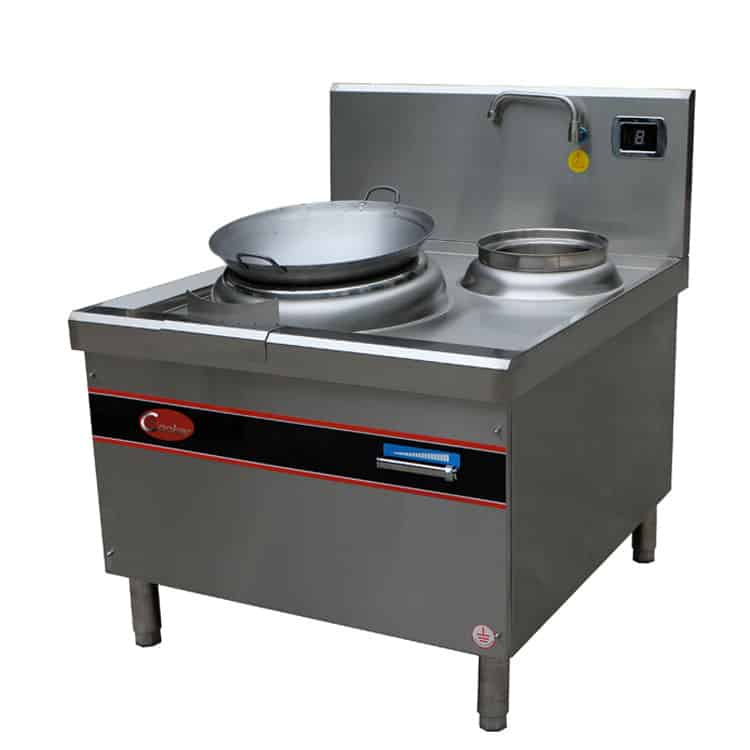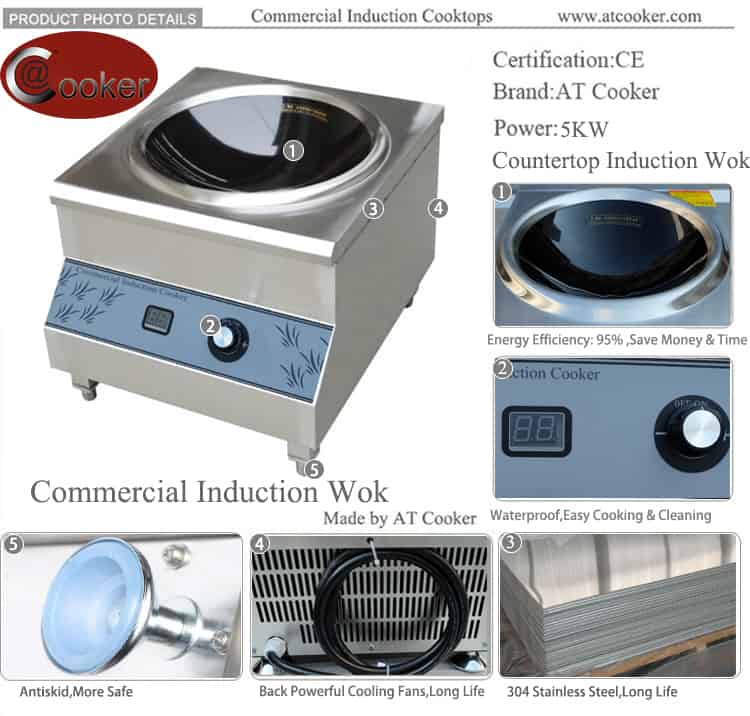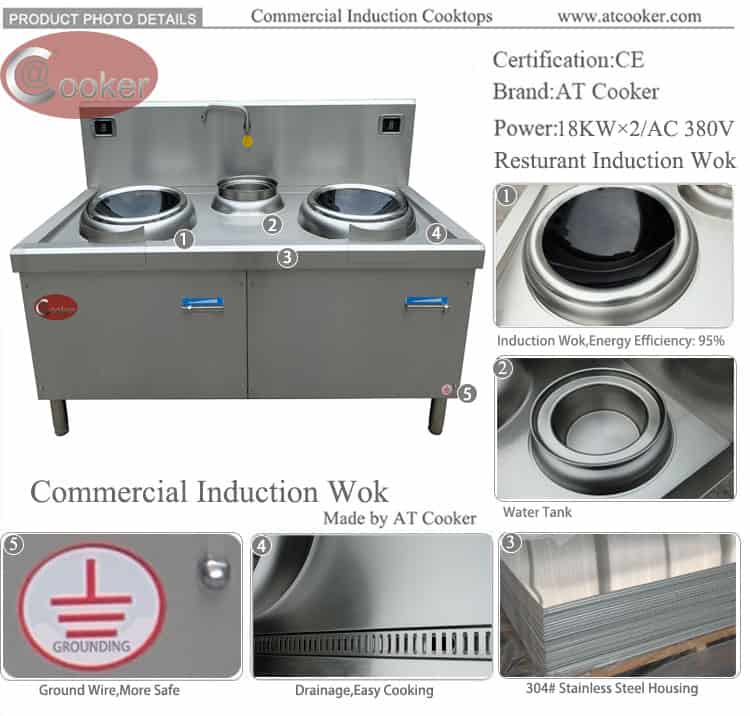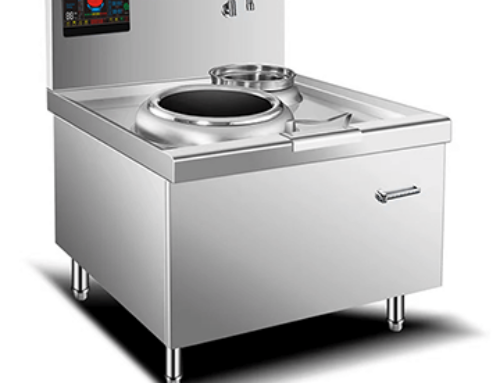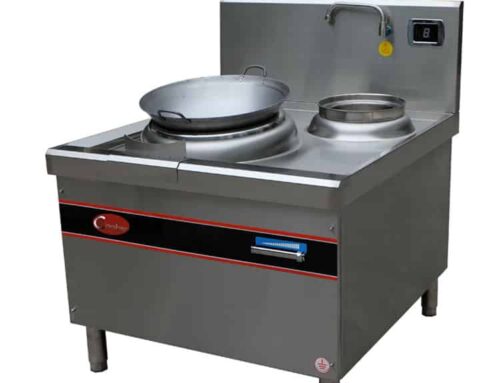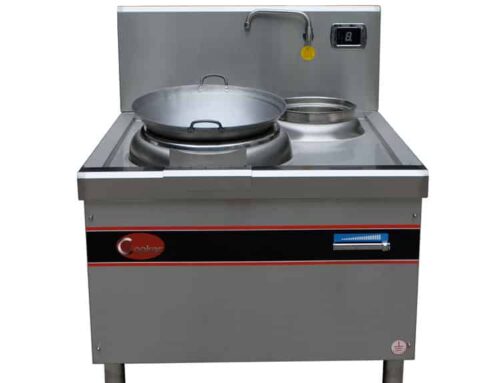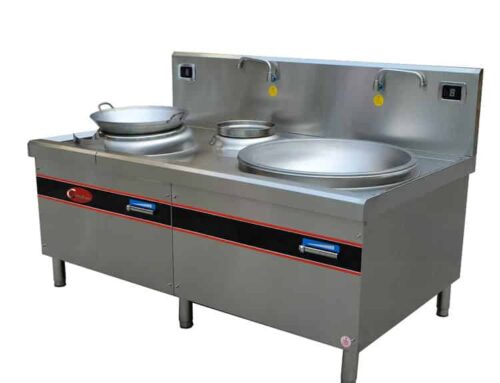How Does the Size of the Wok Station Affect Its Performance and Suitability for Various Kitchen Spaces?
A wok station restaurant’s success hinges on matching the workstation’s size to two critical factors: performance needs (like cooking volume and heat intensity) and spatial constraints (from tiny food stalls to large commercial kitchens). Whether you’re using a compact propane wok burner for a food truck or a full-size wok range for a busy Asian restaurant, size directly impacts efficiency, workflow, and even energy costs. AT Cooker’s commercial induction wok stations—available in countertop (24-inch) and floor-standing (36–48-inch) models—are engineered to balance these needs. Below, we break down how size influences every aspect of a wok station’s function, with real-world examples and data to help you choose the right fit.
1. Larger Wok Stations Accommodate Bigger Woks, Allowing Higher Volume Cooking
The primary advantage of large wok stations (36–48 inches wide) is their ability to fit oversized woks (16–20 inches in diameter)—critical for high-volume cooking in busy restaurants. A 20-inch wok can hold 3–4x more food than a 12-inch wok, letting kitchens prepare batches of stir-fry, noodles, or fried rice for 20+ customers at once.
AT Cooker’s 48-inch wok range (model AT-IW48) supports 20-inch carbon steel woks and features dual induction zones for simultaneous cooking. A hotel in Las Vegas uses this model for banquet service: “We cook 50+ portions of lo mein at once—something we couldn’t do with our old 24-inch station. It cuts batch time by 60%.”
Volume capacity scales with station size:
- Small (24-inch): Fits 12–14-inch woks (2–3 portions per batch).
- Medium (36-inch): Fits 16–18-inch woks (8–10 portions per batch).
- Large (48-inch): Fits 18–20-inch woks (15–20 portions per batch).
2. Small Wok Stations Are Ideal for Limited Kitchen Spaces or Lower Output Needs
Compact wok stations (24 inches wide or smaller) excel in kitchens where space is scarce—like food trucks, mall kiosks, or small wok station restaurant spots with 10–15 seats. Their narrow design (depth: 20–24 inches) fits on countertops or mobile carts, without crowding other equipment like fryers or refrigerators.
AT Cooker’s 24-inch countertop induction wok (model AT-IW24) weighs 45 lbs and fits in standard food truck kitchens. A food truck operator in Austin said: “My kitchen is only 5 feet wide—this small station fits next to my prep table, and I can still move around. It cooks 3 portions of pad thai at once, which matches my customer volume.”
Small stations also shine for “specialty” roles—like a dedicated wok and burner for making sauces or side dishes. A boba tea shop uses a 20-inch propane wok station to cook taro balls: “We don’t need a big station—this one takes up minimal space and does exactly what we need.”
3. Size Affects Heat Intensity; Larger Stations May Have More Powerful Burners
Heat intensity often increases with wok station size—larger models (36+ inches) typically have more powerful heating systems (8–12KW for induction, 100,000+ BTU for gas) to maintain high temperatures across bigger woks. This is critical for stir-frying dense ingredients like beef or root vegetables, which need consistent high heat to sear without steaming.
AT Cooker’s 36-inch wok station uses dual 6KW induction modules, delivering 850°F across a 18-inch wok. A Chinese restaurant in Chicago reported: “Our old small station couldn’t keep up with searing 10 lbs of chicken—now we get perfect charred edges every time.”
Small stations (24-inch) have lower power outputs (3.5–5KW for induction, 50,000 BTU for gas)—enough for light cooking but insufficient for high-heat, large-batch tasks. “We tried a small propane wok burner for our dinner rush, but it cooled down when we added too much food,” said a diner owner. “Upgrading to a medium station fixed the issue.”
| Wok Station Size | Heating Power (Induction) | Heating Power (Gas/Propane) | Max Temperature | Ideal Batch Size |
|---|---|---|---|---|
| Small (20–24 inches) | 3.5–5KW | 40,000–60,000 BTU | 750–800°F | 2–5 portions |
| Medium (30–36 inches) | 6–8KW | 80,000–100,000 BTU | 800–850°F | 8–12 portions |
| Large (42–48 inches) | 10–12KW | 120,000–150,000 BTU | 850–900°F | 15–25 portions |
4. Compact Wok Stations Heat Up Faster and Are Easier to Control
Smaller wok stations have less surface area to heat, so they reach cooking temperature (750°F) 30–50% faster than large models. AT Cooker’s 24-inch induction station heats up in 2 minutes, while the 48-inch model takes 4 minutes—critical for quick-service spots where every second counts.
Compact stations also offer better temperature control: their smaller heating zones are easier to adjust, reducing the risk of hot spots. A fast-casual restaurant in Seattle uses 24-inch stations for custom stir-fries: “We change temperatures 10+ times per order—small stations respond instantly, so every dish is perfect.”
Faster heat-up also cuts idle energy use. A café that operates 6 hours daily saves 0.3 kWh/day with a small station (2-minute preheat vs. 4-minute preheat)—adding up to $16/year in savings.
Small Station (24-inch)
Time to 750°F
Medium Station (36-inch)
Time to 800°F
Large Station (48-inch)
Time to 850°F
5. Large Wok Stations Require More Ventilation and Space for Installation
Large wok stations (36+ inches) demand more installation space and ventilation—key considerations for kitchen layout:
- Floor space: 48-inch stations need 50+ inches of floor length (including 3–4 inches of clearance on each side to prevent overheating).
- Ventilation: Gas/large propane models need hoods with 600+ CFM (vs. 300 CFM for small stations); even induction models require 200+ CFM to remove residual smoke.
- Electrical/gas lines: 12KW induction stations need 240V/50A dedicated circuits; gas stations need 1-inch diameter gas lines (vs. 0.5-inch for small propane burners).
A restaurant in New York learned this during renovation: “We bought a 48-inch wok range without measuring—our kitchen only had 40 inches of free space. We had to rearrange all equipment, adding $2,000 to our budget.” AT Cooker provides free layout checks: “Their team told us our 35-inch space could only fit a 30-inch station—saving us from a costly mistake,” said a café owner.
— Li, Asian Restaurant Owner (New York, NY)
6. Smaller Wok Stations Offer Greater Flexibility in Kitchen Layout
Compact wok stations (24-inch or smaller) are portable and modular, making them easy to integrate into any kitchen layout. They can be mounted on countertops, wheeled carts, or even used outdoors—ideal for pop-ups or temporary events.
AT Cooker’s 20-inch propane wok burner has a built-in handle and weighs 35 lbs—easy for one person to move. A catering company uses it for outdoor weddings: “We load it in a van, set it up on a folding table, and connect it to a propane tank. It’s way more flexible than a large range with wok burner, which would need a truck and dedicated power.”
Flexibility also helps with workflow: small stations can be repositioned to align with prep tables or serving lines. A food court vendor rearranges their 24-inch station weekly: “We move it closer to the counter during rush hour, then back to the wall when it’s slow.”
7. Wok Station Size Impacts the Number of Burners Available Simultaneously
Larger wok stations often include multiple burners or heating zones, letting kitchens cook different dishes at once. A 48-inch wok range may have 2–3 induction zones or gas burners, while small stations have only one.
AT Cooker’s 36-inch station has two independent 6KW zones: “We set one zone to 800°F for stir-frying and one to 300°F for heating sauces,” said a hotel chef. “With our old single-zone station, we had to cook in batches—now we do it all at once.”
Multiple zones also reduce cross-contamination. A sushi restaurant uses separate zones for meat and vegetable stir-fries: “No more worrying about cross-contact—each zone is dedicated to one ingredient type.”
8. Oversized Wok Stations May Lead to Inefficient Energy Use If Underutilized
Choosing a wok station larger than needed wastes energy and space. A small wok station restaurant with a 48-inch station uses only 30% of the surface daily—wasting 70% of the station’s energy (since the entire surface still heats up).
AT Cooker’s customer data shows that 25% of underutilized large stations cost $100–$150 extra monthly in energy. “We bought a 36-inch station for our café, but we only cook 2 portions at a time,” said an owner. “Our energy bill is $80/month higher than it would be with a small station.”
To avoid this, calculate peak batch size first: if you cook 5 portions max, a 24-inch station is sufficient. Save large stations for kitchens serving 15+ customers per hour.
Signs You’re Using an Oversized Wok Station
- Less than 50% of the wok surface is used per batch.
- Energy bills are 30%+ higher than similar-sized restaurants.
- The station is empty for 4+ hours daily.
- You only use one burner/zone on a multi-zone station.
9. Properly Sized Wok Stations Improve Workflow and Cooking Efficiency
A well-sized wok station aligns with kitchen workflow—e.g., a line cooking setup needs small, dedicated stations for each cook, while a batch-cooking kitchen needs a large central station.
A fast-food chain uses 24-inch stations in their line: “Each cook has their own station—no more waiting for space,” said the manager. A hospital cafeteria, however, uses one 48-inch station for batch-cooking 200+ meals—more efficient than multiple small stations.
10. Large Wok Stations Are Suited for Busy Commercial Kitchens with High Demand
High-volume restaurants (serving 50+ customers per hour) need large wok stations to keep up with orders. A 48-inch station can handle 15–20 portions per batch, reducing wait times and increasing table turns.
A busy Chinese restaurant in Los Angeles upgraded to a 48-inch induction station: “We were falling 20 orders behind during dinner rush. Now we cook 3x more food at once—wait times dropped from 15 to 5 minutes.”
Large stations also support specialized equipment like wok racks or oil filters, further improving efficiency. “Our new station has a built-in oil drain—cleanup takes 5 minutes instead of 20,” said a chef.
11. Small Stations Are Better for Small Restaurants or Food Stalls
Small restaurants (10–20 seats) or food stalls don’t need large wok stations—their lower customer volume means a 24-inch station is more than enough. A food stall in Chicago uses a 20-inch propane wok burner: “I serve 10–15 customers per hour—this station cooks fast and fits in my 3×5 foot space.”
Small stations also have lower upfront costs: 24-inch induction models cost $500–$800, vs. $1,500–$3,000 for large stations. “We saved $2,000 by choosing a small station—money we put toward other equipment,” said a new restaurant owner.
12. Wok Station Size Should Align with Menu Requirements and Kitchen Capacity
Menu items dictate station size: if your menu includes large-batch dishes (like fried rice for banquets), a large station is necessary. If you focus on single-serve stir-fries, a small station works.
A catering company specializing in weddings needs a 48-inch station: “We cook 100+ portions of noodles at once—no small station could handle that.” A bistro with single-serve wok dishes uses 24-inch stations: “Our menu doesn’t require big batches—small stations are perfect.”
Kitchen capacity also matters: measure available space before buying. A 48-inch station needs 5 feet of floor space; if your kitchen only has 3 feet, opt for a 24-inch model.
13. Choosing the Right Size Balances Cooking Performance and Spatial Constraints
The best wok station size is a balance of three factors:
- Batch volume: Calculate peak portions per batch (e.g., 10 portions = medium station).
- Kitchen space: Measure available floor/counter space (add 3–4 inches for clearance).
- Menu diversity: Multiple dishes = multi-zone large station; simple menu = small station.
AT Cooker’s wok station restaurant models—from compact 24-inch to industrial 48-inch—are designed to fit every need. Our team provides free size assessments: share your kitchen dimensions and menu, and we’ll recommend the perfect fit. Whether you need a propane wok burner for a food truck or a full-size range with wok burner for a restaurant, proper sizing ensures you get the most from your investment.
Get a Custom Wok Station Size Recommendation
Share your restaurant’s capacity, menu, and kitchen space—we’ll help you choose the right-sized wok station for performance and fit.
